A Time Series Prediction Model of Foundation Pit Deformation Based on Empirical Wavelet Transform and NARX Network
Abstract
1. Introduction
2. Materials and Methods
2.1. Principle of EWT
2.2. Basic Principles of NARX
2.3. Model Prediction Process
2.3.1. Data Decomposition by EWT
2.3.2. Prediction by NARX
2.3.3. Model Performance Evaluation Index
2.4. Project Overview
3. Results and Discussion
3.1. Decomposition of Deformation Data
3.2. Training and Evaluation of Prediction Models
4. Conclusions
Author Contributions
Funding
Acknowledgments
Conflicts of Interest
Abbreviations
| EWT | Empirical wavelet transform |
| EMD | Empirical mode decomposition |
| HHT | Hilbert-Huang transform |
| NAR | Nonlinear autoregressive |
| NARX | Nonlinear autoregressive exogenous |
| MSE | Mean square error |
| MAE | Mean absolute error |
| MRE | Mean relative error |
| IMF | Intrinsic mode function |
References
- Jiang, X.F.; Liu, G.B.; Zhang, W.L. Study on deformation characteristics of ultra-deep foundation pits in Shanghai area based on measured data. J. Rock Soil Eng. 2010, 32, 570–573. [Google Scholar]
- Tan, Y.; Li, M.W. Measured performance of a 26 M deep top-down excavation in Downtown Shanghai. Can. Geotech. J. 2011, 48, 704–719. [Google Scholar] [CrossRef]
- Liao, S.M.; Liu, J.H.; Wang, R.L. Shield Tunneling and Environment Protection in Shanghai soft ground. Tunn. Undergr. Space Technol. 2009, 24, 454–465. [Google Scholar] [CrossRef]
- Tan, Y.; Wei, B. Performance of an Overrestrained Metro station and facilities nearby. J. Perform. Facil. 2012, 26, 241–254. [Google Scholar] [CrossRef]
- Yin, G.Z.h.; Yue, S.H.; Zh, T.; Li, D.Q. Analysis of tunnel displacement time series based on ARMA model. Rock Soil Mech. 2009, 30, 2727–2732. [Google Scholar]
- Xu, Q.; Guo, W.; He, S. Research on prediction of ground settlement in foundation pit excavation based on log-arma combination model. Safety Environ. Eng. 2017, 24, 160–163. [Google Scholar]
- Zhao, Z.X. Analysis and Prediction of Deep Foundation Pit Deformation Based on Time Series Metabolism Method. Master’s Thesis, Shanghai Jiao Tong University, Shanghai, China, 2018. [Google Scholar]
- Cao, J.; Ding, W.Y.; Zhao, D.S.; Song, Z.G.; Liu, H.M. Prediction of foundation pit deformation time series based on lssvm-arma model. Rock Soil Mech. 2014, 35, 579–586. [Google Scholar]
- Ghaderpour, E.; Vujadinovic, T. The Potential of the Least-Squares Spectral and Cross-Wavelet Analyses for Near-Real-Time Disturbance Detection within Unequally Spaced Satellite Image Time Series. Remote Sens. 2020, 12, 2446. [Google Scholar] [CrossRef]
- Li, S.H.M.; Guo, H.D.; Li, D.R. Overview of vibration signal processing methods. Chin. J. Sci. Instrum. 2013, 34, 1907–1915. [Google Scholar]
- Chui, C.K.; Wang, J.Z. A cardinal spline approach to wavelets. Am. Math. Soc. 1991, 113, 785–793. [Google Scholar] [CrossRef]
- Niu, P.F.; Zhang, J.; Zou, G. Study on application of wavelet transform technique to turbine generator fault diagnosis. Chin. J. Sci. Instrum. 2007, 28, 189–192. [Google Scholar]
- Newland, D.E. Ridge and phase identification in the frequency analysis of transient signals by harmonic wavelets. J. Vib. Acoust. 1999, 121, 149–155. [Google Scholar] [CrossRef]
- Huang, N.E.; Shen, Z.; Long, S.R. The empirical mode decomposition and the Hilbert spectrum for nonlin- ear and non-stationary time series analysis. Proc. R. Soc. Lond. Ser. A-Math. Phys. Eng. Sci. 1998, 454, 903–995. [Google Scholar] [CrossRef]
- Huang, N.E.; Wu, Z. A review on Hilbert-Huang transform: Method and its applications to geophysical studies. Rev. Geophys. 2008, 46, RG2006. [Google Scholar] [CrossRef]
- Wang, T. Research on EMD Algorithm and its Application in Signal Denoising. Master’s Thesis, Harbin Engineering University, Harbin, China, 2010. [Google Scholar]
- Gilles, J. Empirical Wavelet Transform. IEEE Trans. Signal Process. 2013, 61, 3999–4010. [Google Scholar] [CrossRef]
- Li, Y.; Wu, H.; Liu, H. Multi-step Wind Speed decomposition using EWT decomposition, LSTM Principal Computing, RELM subordinate computing and IEWT reconstruction. Energy Convers. Manag. 2018, 167, 203–219. [Google Scholar]
- Liu, H.; Wu, H.; Li, Y. Smart Wind Speed Forecasting using EWT decomposition, GWO evolutionary optimization, RELM learning and IEWT reconstruction. Energy Convers. Manag. 2018, 161, 266–283. [Google Scholar]
- Zhuo, Z.Y.; Cao, Q.; Li, Q. Short-term wind power combination prediction based on ewt-kelm method. Electr. Meas. Instrum. 2019, 56, 83–89. [Google Scholar]
- Wang, X.Y.; Li, Q.; Zheng, S. Short-term Wind Power Prediction Based on EWT-ESN. J. Solar Energy 2008, 39, 633–642. [Google Scholar]
- Hu, J.; Wang, J. Short-term wind speed prediction using empirical wavelet transform and Gaussian process regression. Energy 2015, 93, 1456–1466. [Google Scholar] [CrossRef]
- Cui, J.X.; Zou, H.W. Research on Chinese stock market forecast based on ewt-pso-svm error correction combination model. Syst. Sci. Math. 2019, 39, 1212–1235. [Google Scholar]
- Li, Z.H.N.; Zhu, M.; Zhu, F.L.; Xiao, Y.X. Research on mechanical fault diagnosis method based on empirical wavelet transform. Chin. J. Instrum. 2014, 35, 2423–2432. [Google Scholar]
- Chegini, S.N.; Bagheri, A.; Najafi, F. Application of A new ewt-based denoising technique in bearing fault diagnosis. Meas. J. Int. Meas. Confed. 2019, 144, 275–297. [Google Scholar] [CrossRef]
- Thirumala, K.; Pal, S.; Jain, T.; Umarikar, A.C. A Classification method for multiple power quality factor using EWT Based Adaptive Filtering and Multiclass SVM. Neurocomputing 2019, 334, 265–274. [Google Scholar] [CrossRef]
- Yu, H.; Li, H.; Li, Y. Vibration Signal Fusion Using Improved Empirical Transform and Variance Contribution Rate for weak Fault Detection of hydraulic Pumps. ISA Trans. 2020, in press. [Google Scholar] [CrossRef]
- Cheng, T.D.; Wu, Y.W.; Luo, X.Y.; Dai, C.C.; Yin, B.Y. Feature extraction and classification method of mine microseismic signal based on EWT-Hankel-SVD. Acta Instrum. 2019, 40, 181–191. [Google Scholar]
- Liu, Y.Y.; Tian, T.; Wang, C.X. Prediction of structural health state trend based on EWT and FESN. Chin. J. Kinet. 2019, 36, 645–651. [Google Scholar]
- Guo, J.; Zha, L.Y.; Pang, Y.C.h.; Shen, S.S.; Xia, P. Prediction of deep foundation pit surface settlement based on wavelet analysis. J. Geotech. Eng. 2014, 36, 343–347. [Google Scholar]
- Xu, S.; Niu, R. Displacement prediction of Baijiu jected based on empirical mode decomposition and long short-term memory neural network in Three Gorges Area, China. Comput. Geosci. 2018, 111, 87–96. [Google Scholar] [CrossRef]
- Li, M.; Shen, Y.; Ren, Q.; Li, H. A new Distributed Time Series Evolution Model for dam deformation based on Commodity Prices. Adv. Eng. Inform. 2019, 39, 41–52. [Google Scholar] [CrossRef]
- Wen, M.; Zhang, D.L.; Fang, Q.; Zhang, L.Y. NARXNN time series prediction model for ground subsidence during subway station construction. J. Rock Mech. Eng. 2015, 34, 3306–3312. [Google Scholar]
- Wen, M.; Zhang, S.L.; Fang, Q.; Qi, J.; Fang, H.C.; Chen, W.B. Study on nonlinear autoregressive time series prediction method for tunnel surrounding rock deformation. J. Beijing Jiaotong Univ. 2017, 41, 1–7. [Google Scholar]
- Lin, T.G.; Horne, B.G.; Tino, P. Learning long-term dependencies in NARX neural networks. IEEE Trans. Neural Netw. 1996, 7, 1329–1338. [Google Scholar] [PubMed]
- Ma, Q.W.; Liu, S.H.; Zhao, X.C. PCA-NARX Time Series Prediction Model of Surface Settlement during Excavation of Deep Foundation Pit. In Proceedings of the 2020 4th International Conference on Water Conservancy, Hydropower and Building Engineering, Lanzhou, China, 3–5 July 2020. [Google Scholar]
- Liu, H.; Wu, H.; Lv, X.; Ren, Z.; Liu, M.; Li, Y.; Shi, H. An intelligent hybrid Model for Air Pollutant concentration forecasting: Case of Beijing in China. Sustain. Cities Soc. 2019, 47, 101471. [Google Scholar] [CrossRef]
- Liu, M.Y.; Li, Q.L.; Li, Z.J.; Ma, Y.N.; Zhang, H.C.; Jiang, F.Q.; Yao, Y.M. Application of NARX neural network based on wavelet analysis in water level prediction. South-to-North Water Transf. Water Sci. Technol. 2019, 17, 56–63. [Google Scholar]
- Zhang, Z.H.H.; Ma, C.h.; Xu, J.H.; Ouyang, Z.Z. Combined forecast of total power of wind farm by EMD and NARX neural network. Comput. Eng. Appl. 2016, 52, 265–270. [Google Scholar]
- Daubechies, I. Ten Lectures on Wavelets; Society for Industrial and Applied Mathematics: Philadelphia, PA, USA, 1992. [Google Scholar]
- Ge, M. Study on Deformation Law and Influencing Factors of Subway Foundation Pit excavation in Soft soil area of Tianjin. Master’s, Thesis, Beijing Jiaotong University, Beijing, China, 2016. [Google Scholar]
- Wong, C.X.; Worden, K. Generalised NARX Shunting Neuralnet-Work Modeling. Mechanloal Syst. Signal Process. 2007, 21, 553–572. [Google Scholar] [CrossRef]
- Wu, C.Y. Research on the Influence of Subway station Foundation Pit Construction on adjacent Buildings. Ph.D. Thesis, Hunan University, Changsha, China, 2015. [Google Scholar]
- Huang, C.S. Research on deformation prediction Method and Engineering Application of Subway Deep Foundation Pit Excavation. Ph.D. Thesis, Central South University, Changsha, China, 2011. [Google Scholar]


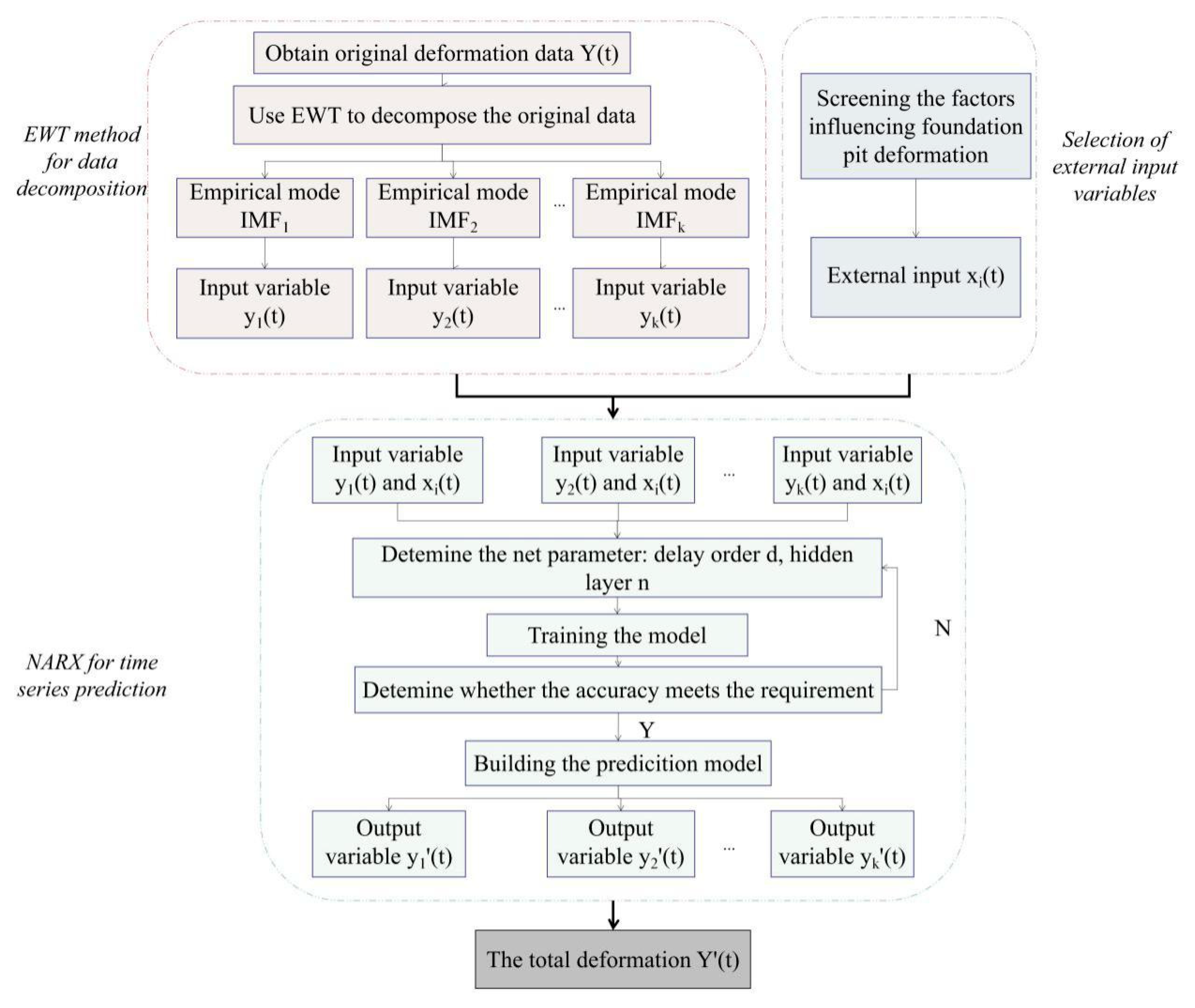

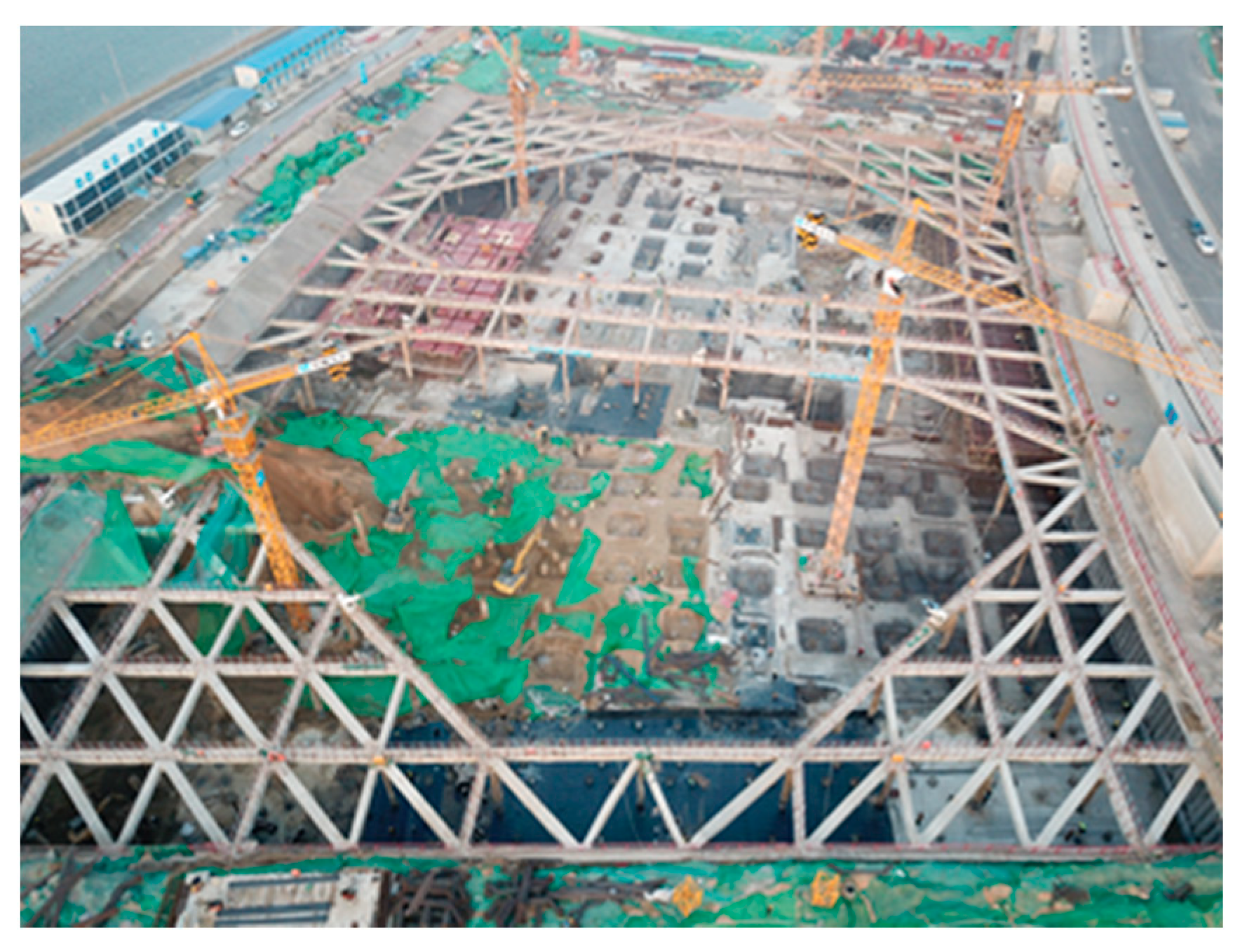
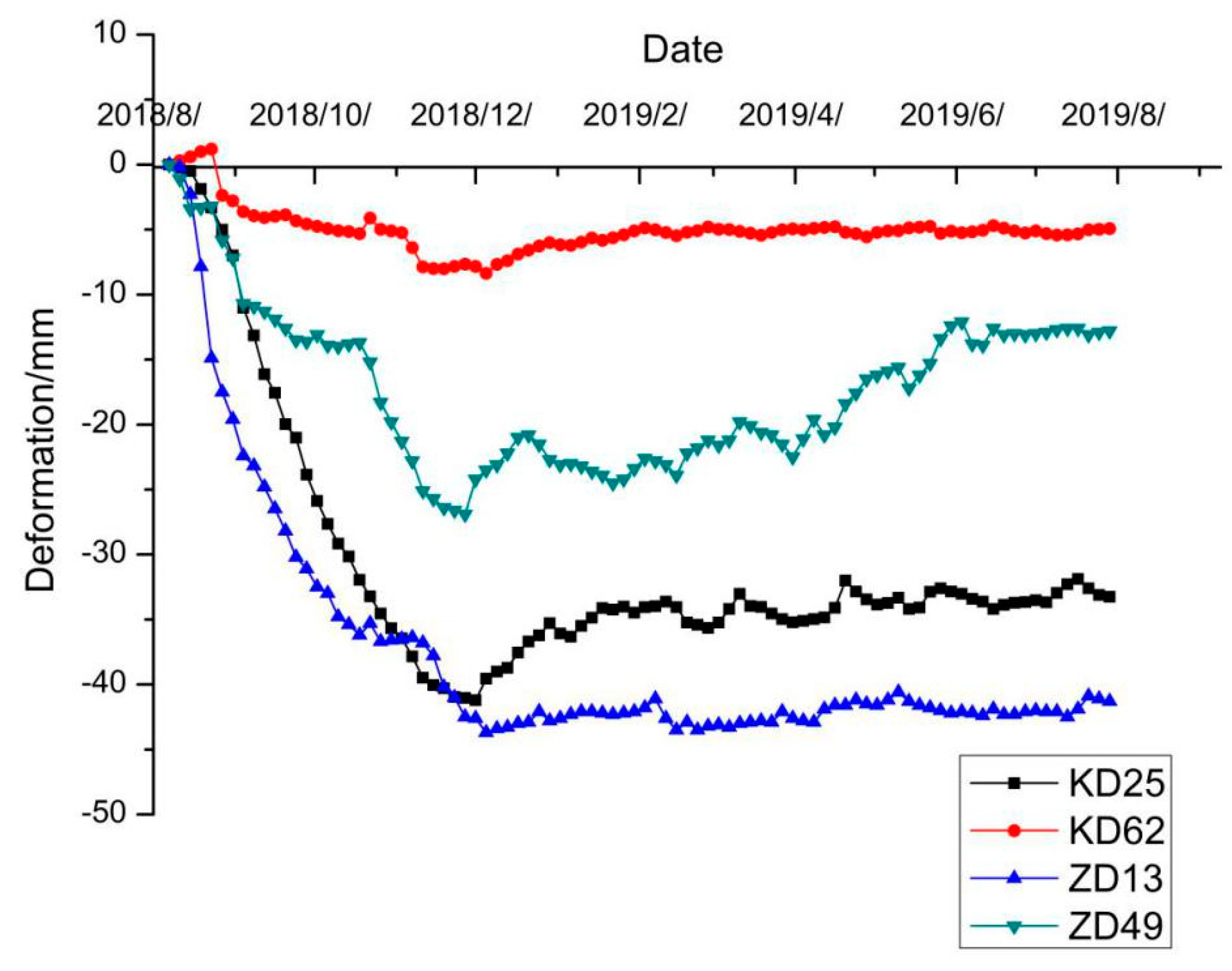
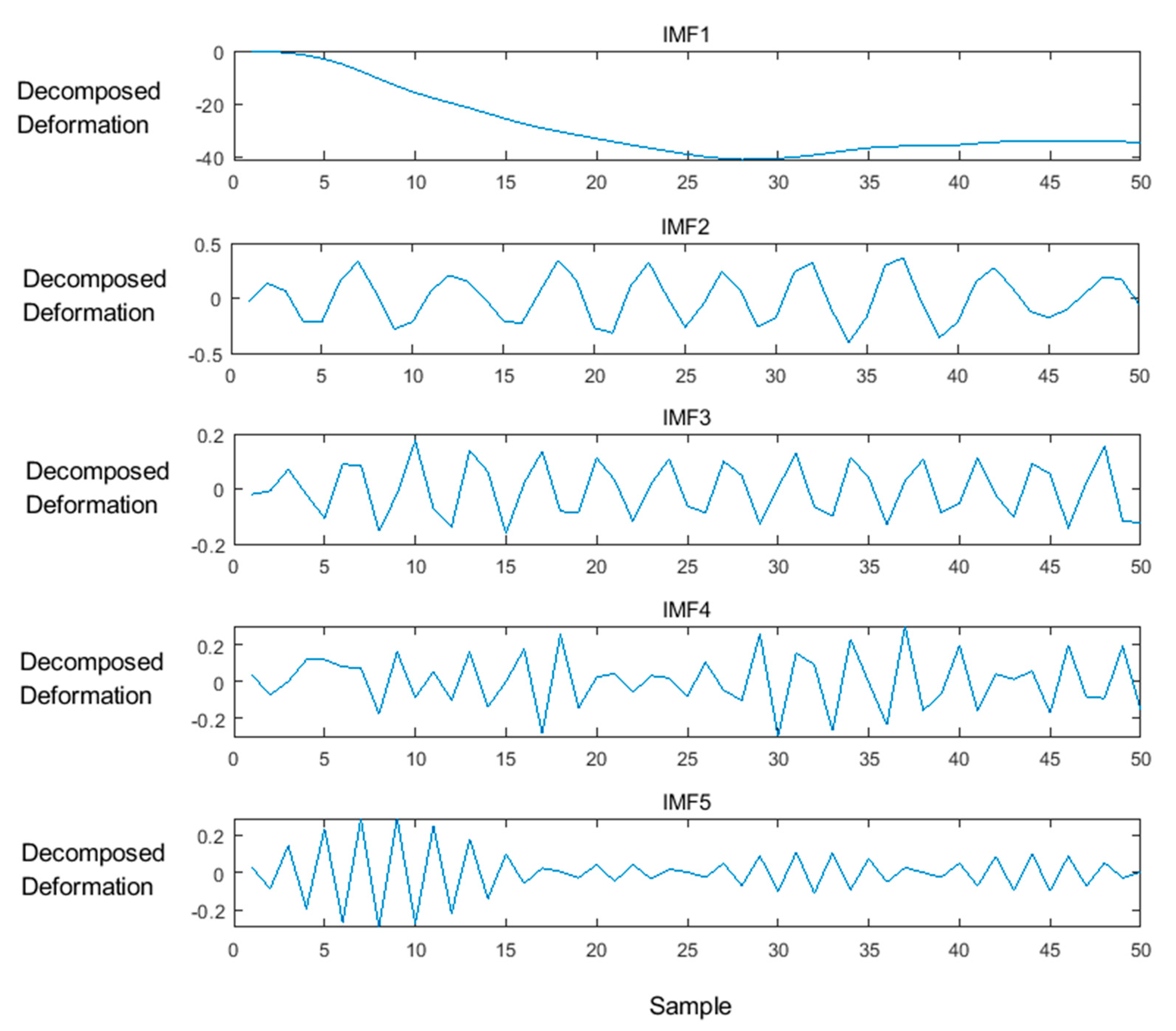
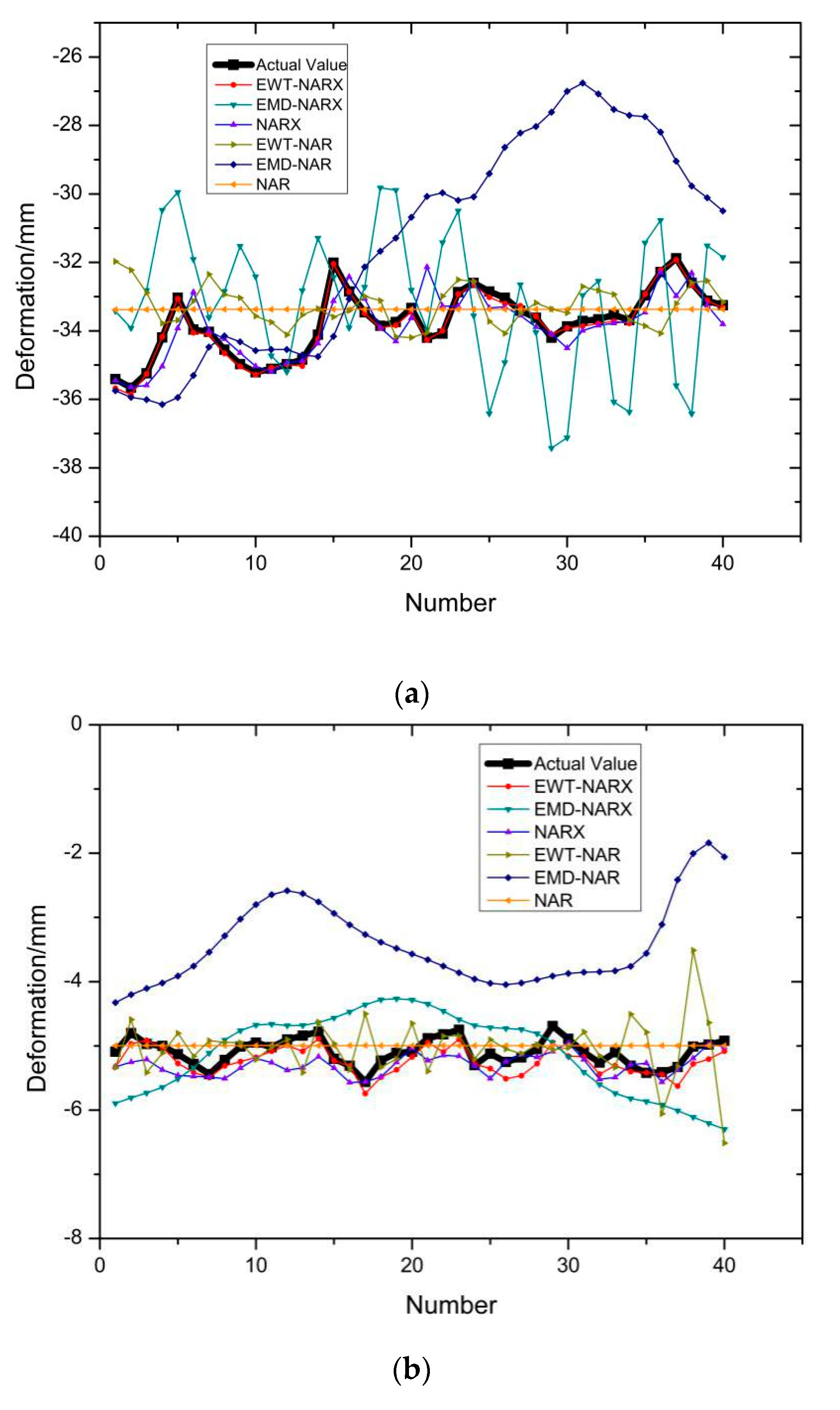
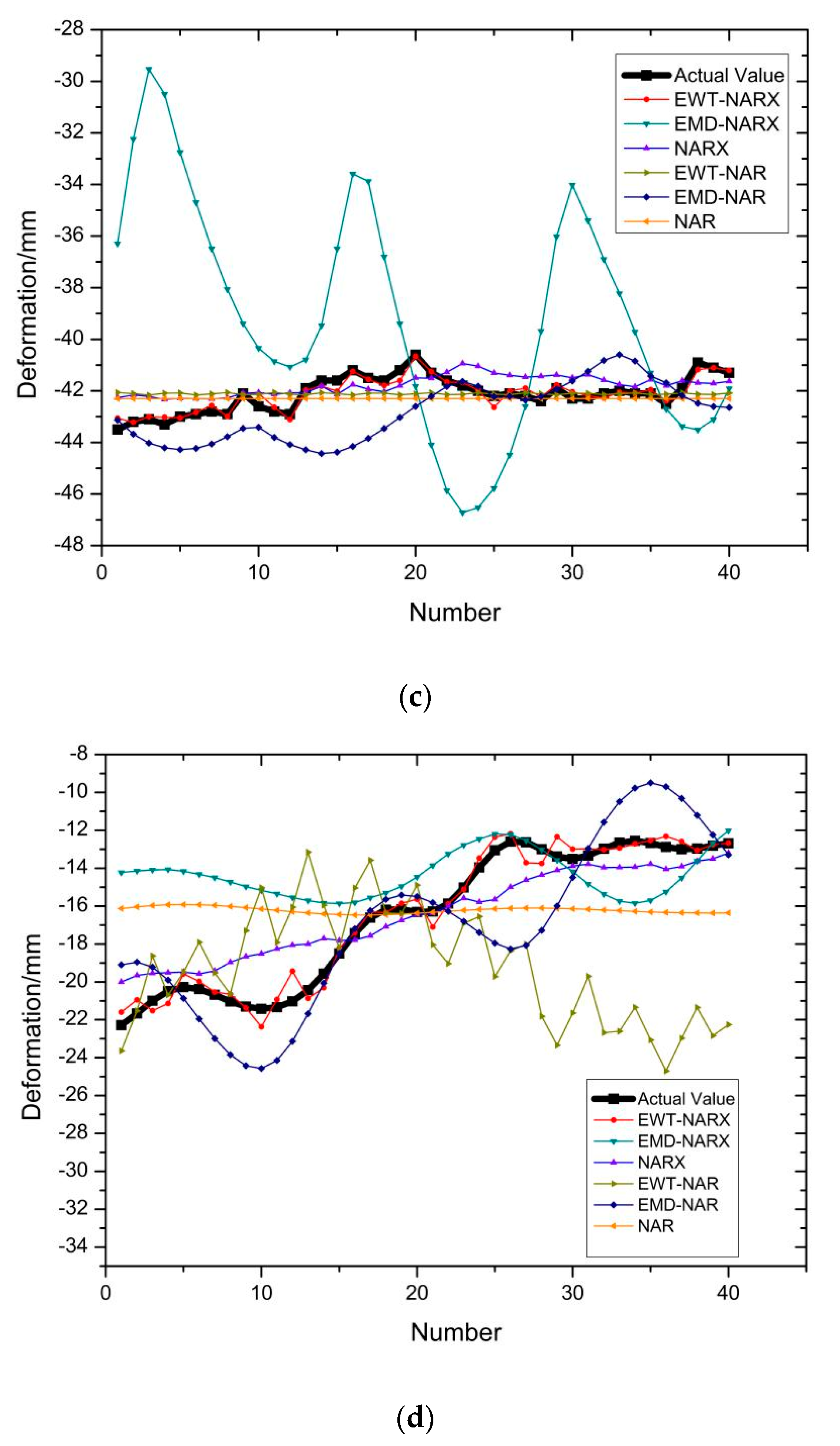
| NAR | NARX | EMD-NAR | EWT-NAR | EMD-NARX | EWT-NARX | ||
|---|---|---|---|---|---|---|---|
| KD25 | MAE | 0.8034 | 0.3977 | 2.8561 | 0.9852 | 1.9873 | 0.0852 |
| MRE | 0.0236 | 0.0119 | 0.0854 | 0.0289 | 0.0589 | 0.0025 | |
| MSE | 1.0121 | 0.3270 | 12.7185 | 1.6048 | 5.3352 | 0.0110 | |
| KD62 | MAE | 0.1856 | 0.2186 | 1.6757 | 0.5485 | 0.3322 | 0.1566 |
| MRE | 0.0359 | 0.0437 | 0.3283 | 0.1074 | 0.0650 | 0.0310 | |
| MSE | 0.0523 | 0.0693 | 3.2487 | 0.4065 | 0.2419 | 0.0332 | |
| ZD13 | MAE | 0.5917 | 0.6148 | 1.1162 | 4.5009 | 0.5587 | 0.1654 |
| MRE | 0.0141 | 0.0146 | 0.0266 | 0.1063 | 0.0133 | 0.0039 | |
| MSE | 0.5157 | 0.4533 | 1.8677 | 31.5032 | 0.4853 | 0.0457 | |
| ZD49 | MAE | 3.2450 | 1.3563 | 2.0306 | 3.1846 | 4.8747 | 0.1311 |
| MRE | 0.1984 | 0.0824 | 0.1337 | 0.1750 | 0.3434 | 0.0081 | |
| MSE | 13.2203 | 2.7092 | 164.9319 | 15.8818 | 37.7021 | 0.0227 |
| NAR | NARX | EMD-NAR | EWT-NAR | EMD-NARX | ||
|---|---|---|---|---|---|---|
| KD25 | MAE | 89.40% | 78.58% | 97.02% | 91.35% | 95.71% |
| MRE | 89.41% | 78.99% | 97.07% | 91.35% | 95.76% | |
| MSE | 98.91% | 96.64% | 99.91% | 99.31% | 99.79% | |
| KD62 | MAE | 15.63% | 28.36% | 90.65% | 71.45% | 52.86% |
| MRE | 13.65% | 29.06% | 90.56% | 71.14% | 52.31% | |
| MSE | 36.52% | 52.09% | 98.98% | 91.83% | 86.28% | |
| ZD13 | MAE | 72.05% | 73.10% | 85.18% | 96.33% | 70.40% |
| MRE | 72.34% | 73.29% | 85.34% | 96.33% | 70.68% | |
| MSE | 91.14% | 89.92% | 97.55% | 99.85% | 90.58% | |
| ZD49 | MAE | 95.96% | 90.33% | 93.54% | 95.88% | 97.31% |
| MRE | 95.92% | 90.17% | 93.94% | 95.37% | 97.64% | |
| MSE | 99.83% | 99.16% | 99.99% | 99.86% | 99.94% |
© 2020 by the authors. Licensee MDPI, Basel, Switzerland. This article is an open access article distributed under the terms and conditions of the Creative Commons Attribution (CC BY) license (http://creativecommons.org/licenses/by/4.0/).
Share and Cite
Ma, Q.; Liu, S.; Fan, X.; Chai, C.; Wang, Y.; Yang, K. A Time Series Prediction Model of Foundation Pit Deformation Based on Empirical Wavelet Transform and NARX Network. Mathematics 2020, 8, 1535. https://doi.org/10.3390/math8091535
Ma Q, Liu S, Fan X, Chai C, Wang Y, Yang K. A Time Series Prediction Model of Foundation Pit Deformation Based on Empirical Wavelet Transform and NARX Network. Mathematics. 2020; 8(9):1535. https://doi.org/10.3390/math8091535
Chicago/Turabian StyleMa, Qingwen, Sihan Liu, Xinyu Fan, Chen Chai, Yangyang Wang, and Ke Yang. 2020. "A Time Series Prediction Model of Foundation Pit Deformation Based on Empirical Wavelet Transform and NARX Network" Mathematics 8, no. 9: 1535. https://doi.org/10.3390/math8091535
APA StyleMa, Q., Liu, S., Fan, X., Chai, C., Wang, Y., & Yang, K. (2020). A Time Series Prediction Model of Foundation Pit Deformation Based on Empirical Wavelet Transform and NARX Network. Mathematics, 8(9), 1535. https://doi.org/10.3390/math8091535




